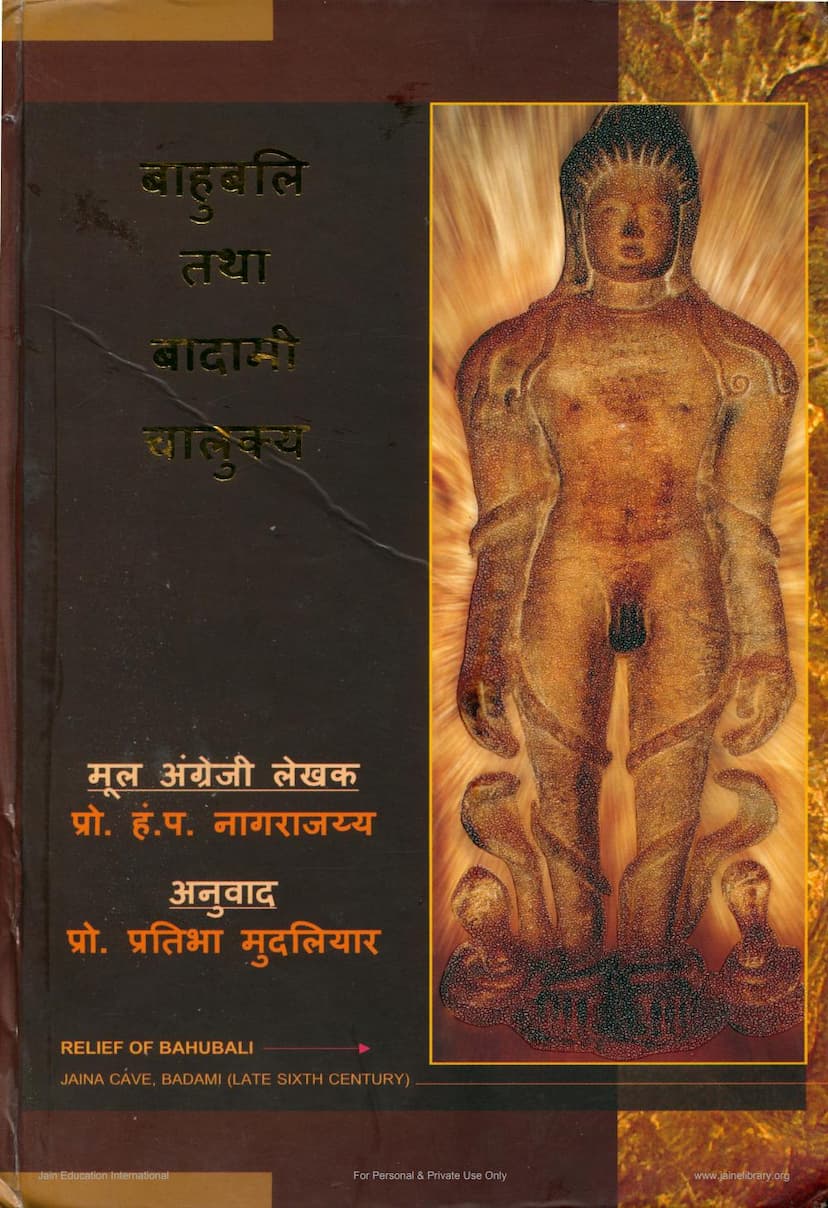Bahubali Tatha Badami Chalukya
Added to library: September 1, 2025

Summary
This is a comprehensive summary of the book "Bahubali tatha Badami Chalukya" by Nagarajaiah Hampa and Pratibha Mudaliyar, based on the provided text:
Book Title: Bahubali tatha Badami Chalukya (Bahubali and Badami Chalukyas)
Author(s): Nagarajaiah Hampa (Original English Author), Pratibha Mudaliyar (Translator)
Publisher: Rashtriya Prakrit Adhyayan tatha Anusandhan Sanstha, Shravanabelagola
Core Focus: The book is a meticulously researched work that explores the deep and multifaceted relationship between Jainism and the Badami Chalukya dynasty, which ruled Southern India from the 6th to the 8th century CE. It highlights the significant contributions of both the Chalukyas to Jainism and Jainism's influence on the art, architecture, literature, and socio-political landscape of the era.
Key Themes and Content:
- Jainism's Prominence under the Chalukyas: The book argues that while previous studies might not have fully captured the extent of Jainism's influence, the Chalukya period was crucial for the growth and patronage of Jainism in Karnataka and beyond. The Chalukyas, through their inscriptions and monumental art, demonstrated a notable encouragement of Jain religious activities.
- Bahubali's Significance: The book emphasizes the importance of Bahubali, a pivotal figure in Jainism. It details his religious and literary significance, noting his presence in epic narratives and his distinct representation in art, particularly in the distinctive "kayotsarga" (standing meditation) posture. The book traces the early sculptural representations of Bahubali and other Jain figures like Adinath, Parshvanath, and various deities, attributing their introduction and prominence in South India to the Badami Chalukyas.
- Architectural and Artistic Contributions: A significant portion of the book is dedicated to the architectural and artistic achievements during the Chalukya rule, with a special focus on Jain art.
- Cave Temples: The Jain cave temples at Aihole and Badami are presented as prime examples of Chalukya patronage and Jain sculptural prowess. The book analyzes the intricate carvings, iconography, and the artistic evolution evident in these caves, particularly highlighting the sculptures of Bahubali, Parshvanath, and various guardian deities (Yakshas and Yakshinis) like Ambika, Padmavati, Jalamalini, and Dharanendra.
- Temples and Sculptures: The book discusses various Jain temples and sculptures, tracing their chronological development and stylistic influences. It highlights the unique features of Jain art during this period, including the iconography of Tirthankaras, the depiction of auspicious symbols, and the integration of local traditions.
- Political and Historical Context: The book situates Jainism within the broader political history of the Badami Chalukyas. It details the rise of the Chalukya empire, their conflicts and alliances with neighboring dynasties (like the Pallavas, Gangas, and Rashtrakutas), and how these political dynamics influenced the patronage and spread of Jainism.
- Feudal System: The book delves into the feudal system prevalent during the Chalukya era, discussing the roles of various feudatories (samantas and mandalikas) and their allegiance to the Chalukya kings. It notes that many of these feudatories were adherents of Jainism.
- Jain Sangha and its Development: The book examines the structure and activities of the Jain Sangha during this period, highlighting the support it received from rulers, merchants, and the general populace. It discusses the role of Jain monks and nuns in spreading Jain principles and contributing to social harmony. The development of various Jain monastic traditions and their spread across different regions is also touched upon.
- Literary Contributions: The book explores the literary output during the Chalukya period, emphasizing the significant role of Jain scholars and poets. It discusses the flourishing of Kannada and Sanskrit literature under royal patronage, with Jain writers making substantial contributions. The significance of inscriptions in both languages for understanding the historical and cultural milieu is underscored.
- Linguistic Evolution: The book traces the linguistic landscape, noting the increasing prominence of Kannada during the Chalukya reign, while Sanskrit continued to be patronized.
- Chronology and Dating: The book relies heavily on epigraphic evidence to establish the chronology of events, rulers, and artistic periods, particularly referencing the use of the Shak era in inscriptions.
- Deities and Iconography: A detailed analysis is provided on the iconography of various Jain deities, especially the guardian deities (Shasanadevatas) like Ambika, Padmavati, Jalamalini, and Dharanendra, and their significance in Jain worship. The book also discusses the depiction of Bahubali, his myths, and his representation in art.
- Enduring Legacy: The book concludes by emphasizing the lasting impact of the Chalukyas on Jain art, architecture, and literature, suggesting that their patronage laid a strong foundation for the continued flourishing of Jainism in South India. The book showcases the intricate interplay of religious devotion, artistic innovation, and political power that characterized this significant period of Indian history.
Overall Significance: "Bahubali tatha Badami Chalukya" is presented as a pioneering and systematically organized work that fills a gap in scholarly understanding by providing a dedicated and comprehensive study of the Jain aspect of the Badami Chalukya reign. It aims to illuminate the previously understated contributions of this dynasty to the development and expansion of Jainism. The book is a testament to the author's extensive research, field work, and deep respect for the subject matter.